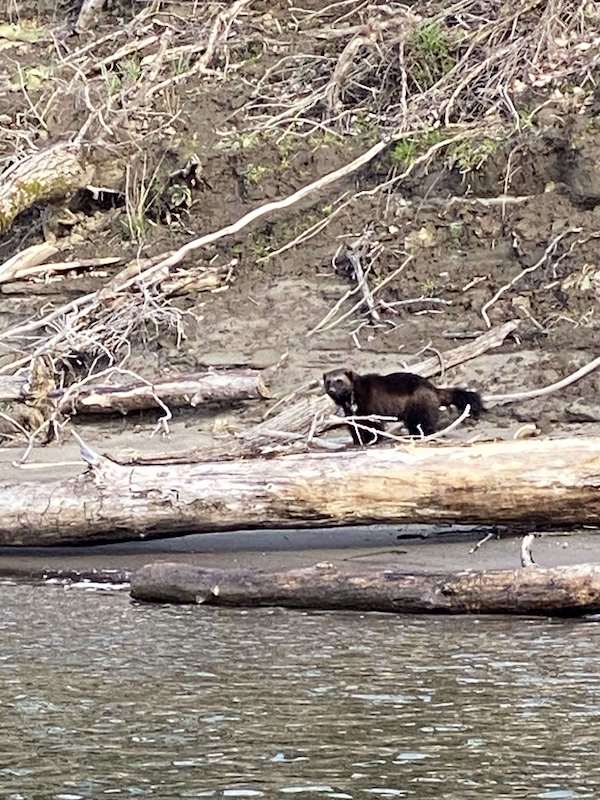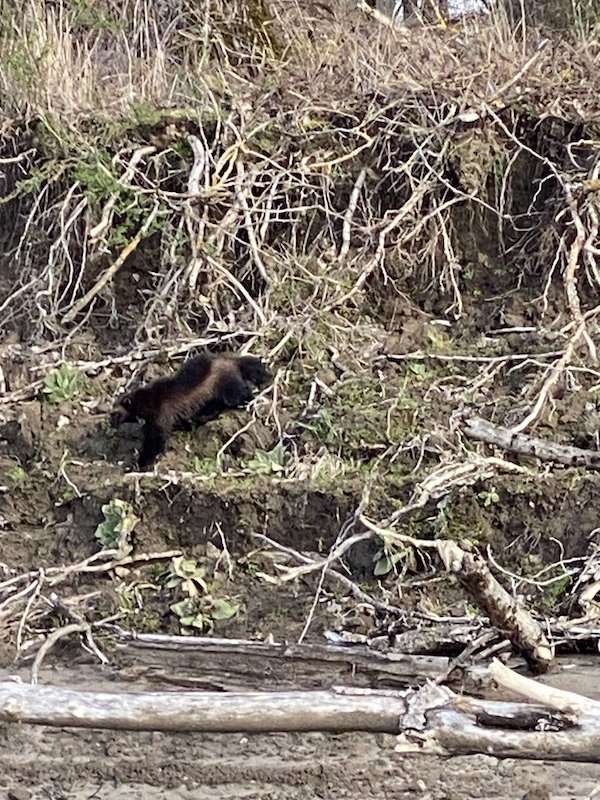
Anglers See Wolverine Along Columbia Near (Checks Notes) Portland?!
THE FOLLOWING IS AN OREGON DEPARTMENT OF FISH AND WILDLIFE PRESS RELEASE
A wolverine was sighted by two people who were fishing on the Columbia River near Portland on the morning of Monday, March 20. Wolverine, rare and listed as threatened in Oregon, are the largest member of the weasel family and resemble a small bear. This is the first confirmed report of a wolverine outside of the Wallowa Mountains in over 30 years.

Photos of the wolverine taken by the anglers were shared with staff from Cascadia Wild , a local non-profit organization conducting community science wildlife surveys for wolverine on Mt. Hood, and Oregon Department of Fish and Wildlife staff.
ODFW wildlife biologists organized a visit to the site of the observation with Cascadia Wild staff on Tuesday morning, March 21. The location and date of the photos were verified, and a search of the area resulted in the discovery of a set of wolverine tracks. No other sign was found.
“Given the proximity to Portland, we were very surprised when this report came in and elated when we were able to verify the sighting,” said ODFW District Wildlife Biologist Dave Keiter. “We really appreciate the people who reported this rare occurrence and Cascadia Wild who helped us confirm the report and begin monitoring efforts.”
ODFW and Cascadia Wild deployed two non-invasive monitoring stations (each consisting of a motion-detecting camera and a hair-collecting device baited with a strong-smelling attractant) in the nearby area. The cameras, which have cellular capability, will allow ODFW to verify if the wolverine is still present in the area. If the wolverine deposits hair on the hair-collecting device and a DNA sample is obtained, it could be possible to identify the individual if it was sampled elsewhere and determine where it came from through population genetics. Volunteers from Cascadia Wild looked for additional tracks and sign nearby and collected two unidentified scats, which may be genetically tested for individual identification.

Wolverine are widely distributed in Canada and Alaska, with smaller populations occurring in Washington, Idaho, Montana, Wyoming and Oregon, which is at the southern edge of the current wolverine range in North America. They are strongly associated with snowpack and are most commonly found at high elevations within the southern extent of their distribution.
It is likely that this animal was dispersing as the habitat in the area doesn’t meet the life history requirements of wolverines. Wolverine can travel over 30 miles in a day, so it is likely the animal is already long gone from where it was sighted. Chances that it remains in the Portland metro area and is detected again by the sampling devices are relatively low, but it could be observed again as it continues its travels. ODFW will continue to monitor the area in the immediate future.
Cascadia Wild and ODFW encourage people to report additional sightings of the wolverine. Unique wildlife observations can happen anywhere and community science is an important part of monitoring and conservation efforts. “Some of the best information on wildlife can come from regular people who are paying attention to what they see,” said Teri Lysak, wolverine tracking coordinator with Cascadia Wild. “Many thanks to the couple who saw this animal and took the time to share it with us.”
Cascadia Wild’s Wolverine Tracking Project and surveys in Mt. Hood National Forest include winter tracking, summer scat, and year-round camera surveys. The surveys are part of a long-term research project collecting data on the forest’s rare carnivores and other wildlife.
Wolverines are thought to have been extirpated from Oregon by 1936, though reports were documented each decade from the 1960s to the 1990s, including locations in Linn, Harney, Wheeler, Deschutes and Grant counties. Most accounts reported are visual encounters that can be difficult to verify. However, a wolverine hit by a car on I-84 near Cascade Locks was surrendered to ODFW in 1990. A 2010-2012 monitoring project confirmed three individual wolverines in northeastern Oregon, an area with no prior documentation of wolverines. In 2008, a wolverine (probably of Rocky Mountain origin) was confirmed in northern California, the first such evidence in almost 90 years. Before the confirmed sighting this week, the most recent observation of a wolverine in Oregon was in 2022 in Wallowa County.
As part of a massive survey effort including seven western states, ODFW staff deployed and monitored 20 wolverine bait stations during the fall and winter of 2021-2022 across modeled habitat in Oregon, primarily the Cascades and northeast Oregon. This collaborative effort was supported by ODFW staff across the state, U.S. Forest Service, National Park Service, Confederated Tribes of Warm Springs, Cascadia Wild, and the Wallowa Wolverine Project.
Only one station in northeast Oregon detected a wolverine. Based on photographic evidence of healed injuries to a front foot and unique coloration on the chest, the wolverine was identified as the resident adult male that has been documented in the area since 2011.
ODFW and partners expect to repeat the forest carnivore study in another five years, part of ongoing range-wide efforts to analyze wolverine occupancy.

